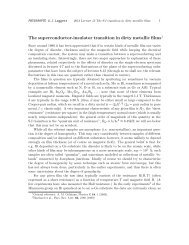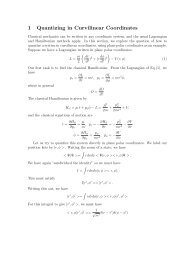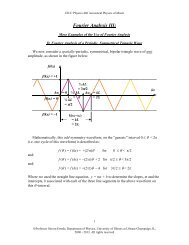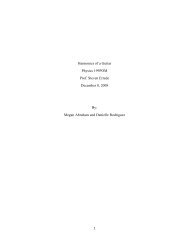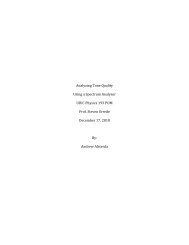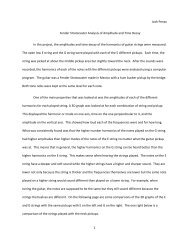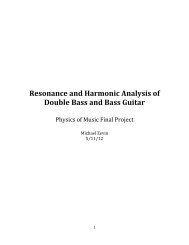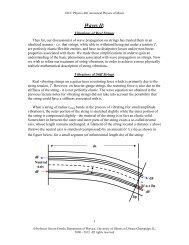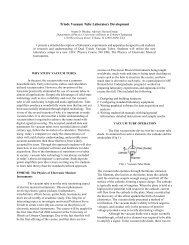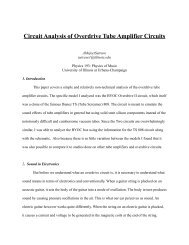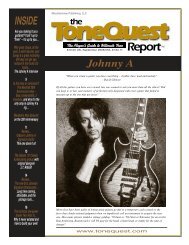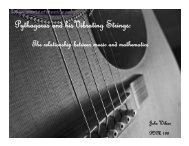The Sounds Produced by the Vibraphone and the Marimba
The Sounds Produced by the Vibraphone and the Marimba
The Sounds Produced by the Vibraphone and the Marimba
You also want an ePaper? Increase the reach of your titles
YUMPU automatically turns print PDFs into web optimized ePapers that Google loves.
<strong>The</strong> <strong>Sounds</strong> <strong>Produced</strong> <strong>by</strong> <strong>the</strong> <strong>Vibraphone</strong><br />
<strong>and</strong> <strong>the</strong> <strong>Marimba</strong><br />
Nicholas Dettman <strong>and</strong> Dana Kurtz<br />
Professor Steve Errede<br />
Physics 199 POM<br />
Fall 2004<br />
1
Many different kinds of percussion instruments exist, which are played <strong>and</strong><br />
produce sound in a variety of ways. For our project, we investigated <strong>the</strong> different sounds<br />
that can be produced <strong>by</strong> two different mallet percussion instruments, <strong>the</strong> marimba <strong>and</strong> <strong>the</strong><br />
vibraphone. <strong>The</strong> modern marimba is similar to <strong>the</strong> xylophone, with wooden, pitched bars<br />
that are struck with a mallet. <strong>The</strong> marimba has shallower, wider bars than a xylophone,<br />
<strong>and</strong> <strong>the</strong> bars are usually made out of rosewood. Each marimba bar is suspended above a<br />
tubular metal resonator, giving <strong>the</strong> marimba a full, resonant tone. <strong>Marimba</strong>s usually have<br />
a four octave range, from C3 to C7.<br />
<strong>The</strong> first vibraphone was constructed in <strong>the</strong> United States in 1907. Originally,<br />
vibraphone bars were made of bronze or steel. Now, <strong>the</strong>y are typically made of a very<br />
hard light-metal alloy. Like <strong>the</strong> bars of a marimba, <strong>the</strong> bars of a vibraphone are<br />
suspended over metal resonator tubes. <strong>The</strong> vibraphone, however, has a small electric<br />
motor which controls rotating metal disks located at <strong>the</strong> top of each resonator tube. When<br />
<strong>the</strong> motor is turned on, <strong>the</strong> rotation of <strong>the</strong> disks causes <strong>the</strong> air columns in <strong>the</strong> tubes to<br />
pulsate, resulting in a tremolo effect. Usually, a vibraphone has a three octave range,<br />
from F to F3. A pedal presses a felt lined rail against <strong>the</strong> rows of bars, allowing <strong>the</strong> bars<br />
to be damped or ring freely. Like <strong>the</strong> marimba, vibraphone bars are struck with a mallet.<br />
<strong>Marimba</strong> <strong>and</strong> vibraphone bars can also be bowed, usually with an orchestral bass bow.<br />
We decided to keep a constant C4 note in all of <strong>the</strong> sound files, so that we could<br />
observe <strong>the</strong> difference of three variants: instrument, type of mallet, <strong>and</strong> location. For <strong>the</strong><br />
instrument, we used a Deagan 3-octave vibraphone <strong>and</strong> a Musser 4 1/3-octave rosewood<br />
marimba. For <strong>the</strong> mallets, we decided on six varying styles of mallets, ranging from hard<br />
rubber to soft yarn, in addition to <strong>the</strong> bow. <strong>The</strong> location refers to <strong>the</strong> location we struck<br />
2
<strong>the</strong> bar. <strong>The</strong> maximum resonance is achieved when <strong>the</strong> exact center of <strong>the</strong> bar is struck,<br />
directly above <strong>the</strong> resonator tube. <strong>The</strong> minimum resonance is achieved when <strong>the</strong> node of<br />
<strong>the</strong> bar, <strong>the</strong> area just above where <strong>the</strong> strings suspend <strong>the</strong> bar, is struck. Here is a visual<br />
representation of <strong>the</strong> playing surface:<br />
<strong>The</strong> first thing we wanted to look at was how <strong>the</strong> bow would affect <strong>the</strong> sound<br />
waves produced. <strong>The</strong> harmonics that were most prevalent in both instruments were <strong>the</strong><br />
fundamental, fourth, seventh, <strong>and</strong> tenth; or every third harmonic. Those are <strong>the</strong> only<br />
harmonics we looked at for <strong>the</strong> bow analysis.<br />
<strong>The</strong>re were two main aspects of <strong>the</strong> sound wave that we looked at: amplitude <strong>and</strong><br />
frequency. <strong>The</strong> amplitudes of <strong>the</strong> harmonics we looked at are similar, yet slightly<br />
different between <strong>the</strong> two instruments. In both instruments, <strong>the</strong> most prevalent harmonic<br />
was <strong>the</strong> fundamental, with <strong>the</strong> least prevalent being <strong>the</strong> seventh harmonic. With <strong>the</strong><br />
vibes, <strong>the</strong> tenth harmonic was more prevalent than <strong>the</strong> fourth harmonic, whereas with <strong>the</strong><br />
marimba, it’s vice versa. What really sticks out is how much fluctuation happened in <strong>the</strong><br />
amplitudes of <strong>the</strong>se harmonics with respect to time. Here’s what <strong>the</strong> vibes looks like:<br />
3
<strong>The</strong> graph of <strong>the</strong> amplitudes of <strong>the</strong> harmonics on marimba looks even more hectic than<br />
this does. Also, all <strong>the</strong> harmonics were louder on <strong>the</strong> vibes.<br />
Analysis of <strong>the</strong> frequencies produced some pretty crazy results as well. We found<br />
that at <strong>the</strong> higher harmonics, <strong>the</strong> frequency becomes very unstable. We observed this in<br />
all of our analyses of <strong>the</strong>se mallet instruments, but found it most noticeable when we used<br />
<strong>the</strong> bow. Looking at just <strong>the</strong> two instruments, <strong>the</strong> vibes appear to have more stable upper<br />
harmonics than <strong>the</strong> marimba does. It was very noticeable in <strong>the</strong> sound file itself also,<br />
because if you listened to it you could hear <strong>the</strong> note bend a little flat towards <strong>the</strong> end of<br />
<strong>the</strong> recording, which is right where <strong>the</strong> fourth <strong>and</strong> seventh harmonics start to waver, as<br />
you can see here:<br />
4
<strong>The</strong> frequencies <strong>the</strong> vibes produced were much more stable than that, with only <strong>the</strong> tenth<br />
harmonic showing any kind of flux. We found that <strong>the</strong>re’s a lot of instability in <strong>the</strong> tone<br />
that’s produced when a marimba or vibraphone is played with a bow. Luckily, it’s not<br />
<strong>the</strong> quality of tone that we enjoy, but <strong>the</strong> uniqueness of <strong>the</strong> sound that it produces, which<br />
is likely in part of its instability.<br />
Next, we decided to look at <strong>the</strong> harmonics produced <strong>by</strong> <strong>the</strong> different locations of<br />
<strong>the</strong> bar, <strong>the</strong> center <strong>and</strong> <strong>the</strong> node. For this analysis, we used a pair of Malletech NR13B<br />
medium-hard rubber mallets. We obtained some very interesting results about <strong>the</strong><br />
amplitudes <strong>and</strong> frequencies produced <strong>by</strong> striking <strong>the</strong> node of <strong>the</strong> bar versus hitting <strong>the</strong><br />
center of <strong>the</strong> bar, as well as playing ei<strong>the</strong>r a marimba or a vibraphone.<br />
We also found some intriguing results when we looked at which harmonics were<br />
most prevalent in each of <strong>the</strong> four scenarios. We found that <strong>the</strong> first <strong>and</strong> fourth<br />
harmonics were very apparent in all but one situation: when <strong>the</strong> marimba was played on<br />
<strong>the</strong> node. One of <strong>the</strong> harmonics that stuck out didn’t appear to actually be an integer<br />
harmonic, but ra<strong>the</strong>r, a harmonic halfway in between <strong>the</strong> fifth <strong>and</strong> <strong>the</strong> sixth harmonics.<br />
5
Also, when <strong>the</strong> vibes were struck on <strong>the</strong> node, one of <strong>the</strong> harmonics that really stuck out<br />
was <strong>the</strong> 17 th harmonic. Both of <strong>the</strong>se harmonics aren’t as prevalent in any analysis we<br />
did of recordings in which <strong>the</strong> center of <strong>the</strong> bar was played.<br />
Just looking at <strong>the</strong> vibraphone, it was interesting to see that striking <strong>the</strong> node took<br />
away <strong>the</strong> presence of <strong>the</strong> first harmonic. <strong>The</strong> left graph is with <strong>the</strong> center of <strong>the</strong> bar, <strong>and</strong><br />
<strong>the</strong> right graph is <strong>the</strong> node of <strong>the</strong> bar. <strong>The</strong> first two columns are <strong>the</strong> same harmonics: first<br />
<strong>and</strong> fourth, <strong>and</strong> look at <strong>the</strong> relationship between <strong>the</strong>m:<br />
It’s clearly visible that <strong>the</strong> second harmonic is <strong>the</strong> most prevalent when <strong>the</strong> node of <strong>the</strong><br />
bar is struck instead of <strong>the</strong> center of <strong>the</strong> bar.<br />
When <strong>the</strong> harmonics of <strong>the</strong> two instruments are analyzed between <strong>the</strong> different<br />
mallet choices with <strong>the</strong> location constant, <strong>the</strong>re are some general trends that can be seen.<br />
<strong>The</strong> harmonics that are most prevalent when <strong>the</strong> vibes are played are <strong>the</strong> first, fourth,<br />
eighth, tenth, <strong>and</strong> thirteenth. With <strong>the</strong> marimba, <strong>the</strong> eighth <strong>and</strong> thirteenth harmonic were<br />
never as apparent as <strong>the</strong>y were in <strong>the</strong> vibes sound. <strong>The</strong> most prevalent harmonics for <strong>the</strong><br />
marimba only included <strong>the</strong> first, fourth, <strong>and</strong> tenth.<br />
One interesting observation from looking at <strong>the</strong> different types of mallets that<br />
were used, is that when <strong>the</strong> hard rubber mallets are compared with <strong>the</strong> two-tone yarn<br />
6
mallets (two-tone is when <strong>the</strong> outside is really soft <strong>and</strong> <strong>the</strong> inside is really hard, so<br />
depending on how hard you strike <strong>the</strong> instrument you can ei<strong>the</strong>r get a soft, more mellow<br />
sound or a harder, more striking sound), <strong>the</strong> two-tone mallets excited more of <strong>the</strong> second<br />
harmonic than <strong>the</strong> hard rubber did for <strong>the</strong> vibes, but had <strong>the</strong> opposite affect when played<br />
on <strong>the</strong> marimba. Also, on <strong>the</strong> vibes, <strong>the</strong> two-tone mallets had a much more stable<br />
thirteenth harmonic than <strong>the</strong> hard rubber, as is shown below:<br />
<strong>The</strong> graph on <strong>the</strong> left shows <strong>the</strong> two-tone mallet, while <strong>the</strong> graph on <strong>the</strong> right shows <strong>the</strong><br />
hard rubber mallet. <strong>The</strong> purple line shows <strong>the</strong> thirteenth harmonic.<br />
<strong>The</strong> same observation can be made when looking at <strong>the</strong> frequencies of <strong>the</strong>se same<br />
two mallets on <strong>the</strong> vibes. When <strong>the</strong> hard rubber mallet is played, <strong>the</strong> thirteenth harmonic<br />
fluctuates much more than it does when <strong>the</strong> vibes are played with <strong>the</strong> two-tone mallet:<br />
7
Ano<strong>the</strong>r interesting thing to note is that <strong>the</strong> tenth harmonic (<strong>the</strong> light blue line) has<br />
greater fluctuation when played with <strong>the</strong> two-tone mallets. This kind of instability<br />
distinction from <strong>the</strong> harmonics is not seen in <strong>the</strong> analysis of <strong>the</strong> marimba recordings.<br />
Bibliography<br />
Blades, James. Percussion Instruments <strong>and</strong> <strong>the</strong>ir History. London: Faber <strong>and</strong> Faber,<br />
1975. 407-410.<br />
Brindle, Reginald. Contemporary Percussion. London: Oxford UP, 1970. 41-47.<br />
Holl<strong>and</strong>, James. Percussion. London: Macdonald <strong>and</strong> Jane's, 1978. 163-165.<br />
8



